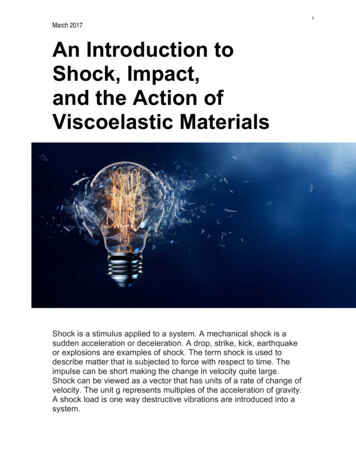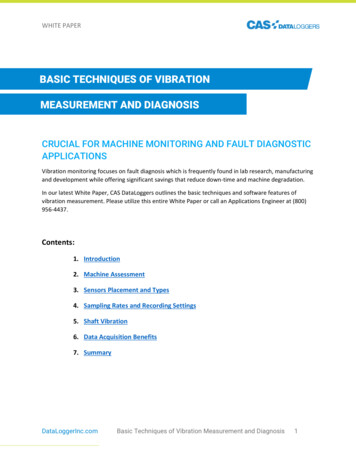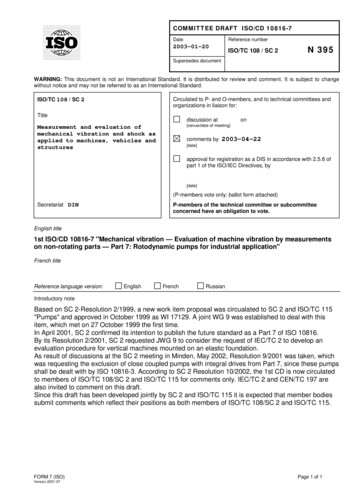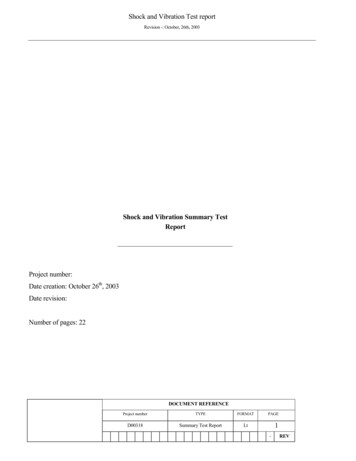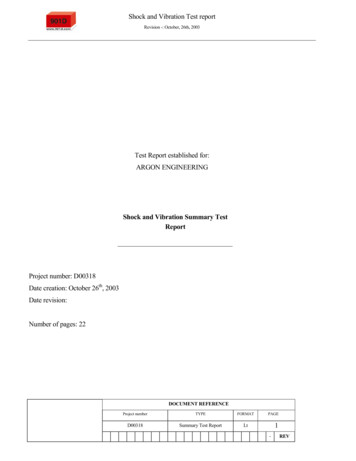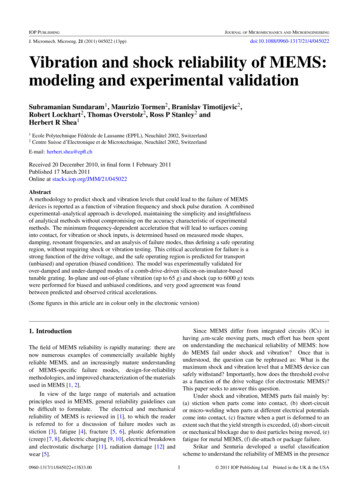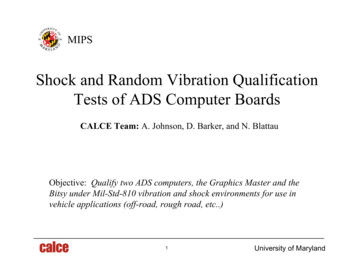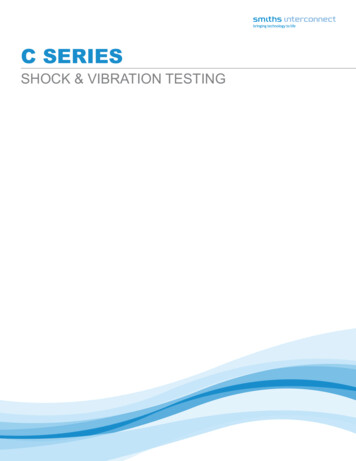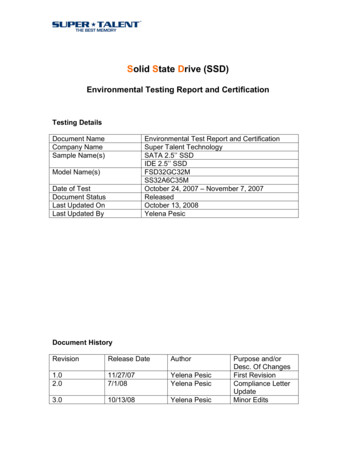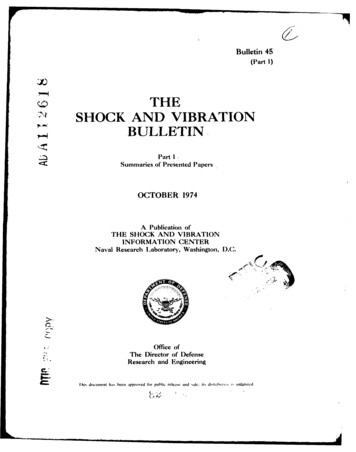
Transcription
Bulletin 45(Part 1)THESHOCK AND VIBRATIONBULLETINPart 1.Summaries of Presented PapersOCTOBER 1974A Publication ofTHE SHOCK AND VIBRATIONINFORMATION CENTERNaval Research Laboratory, Washington, D.C.Office ofThe Director of DefenseResearch and EngineeringI his doctiment has been approved for public releasc and salcits distiihmo, i,unlinwicd
SYMPOSIUM MANAGEMENTTHE SHOCK AND VIBRATION INFORMATION CENTERHenry C. Pusey, DirectorEdward H. Schell, CoordinatorRudolph H. Volin, CoordinatorBulletin ProductionGraphic Arts Branch, Technical Information Division,Naval Research Laboratory
Bulletin 45(Part 1)THESHOCK AND VIBRATIONBULLETINOCTOBER 1974A Publication ofTHE SHOCK AND VIBRATIONINFORMATION CENTERNaval Research Laboratory, Washington, D.C.45th Shock and Vibration SymposiumConvention CenterDayton, Ohio22-25 October 1974HostsAir Force Flight Dynamics Laboratory. Air ForceMaterials Laboratory. and Aeronautical Systems Division,Air Force Systems Command. Wright-Patterson AFB. OhioOffice ofThe Director of DefenseResearch and EngineeringA
//FOREWORDNThis part of the Shock and Vibration Bulletin is published prior to the meeting.Actual papers will be published in later parts.Several reasons exist for so doing:(1) The summaries in this part are delivered to registrants in advance of the meetingto enable them to choose more wisely the papers which they wish to hear.(2) It is our intent that these advance summaries be used to formulate pertinentquestions and comments to be posed during the question and answer sessions at themeeting.(3) Some of the papers to be presented are not offered for publication in thebulletin.(4) Papers covering a very useful piece of work may fail to survive the refereeingprocedure for reasons unrelated to the work itself.In the latter two cases, the summaries provide information not otherwise available,and if one is interested in further details, he may contact the authors. Thus, it becomesimportant to publish this information where it may be referenced in other papers andbecomes a part of the useful body of literature.In particular, we request you to use these summaries to prepare questions for thediscussion periods following the paper presentation. Nothing adds to a symposium quiteas much as an interesting and informative question and answer session. In controversialareas, it is quite useful to have other views presented. We encourage you to prepare foran active participation in the discussions. Rest assured that your questions and commentswill be appreciated.iii,
CONTENTS:Part IImpact,EXPLOSIVELY PROPELLED ROTATING PLATES FOR OBLIQUEIMPACT EXPERIMENTS .F. H. MathewsIMPACT TESTING USING A VARIABLE ANGLE ROCKET LAUNCHERH. W. Nunez1.EVALUATION OF THE SHOCK PULSE TECHNIQUE TO THE UH-1SERIES HELICOPTER .J. A. George, T. C. Mayer and E. F. Covill2STRUCTURAL RESPONSE MODELING OF A FREE-FALL MINE ATW ATER ENTRY .R. H. Waser, G. L. Matteson and J. W. Honaker3Packaging and Shipping,HIGHWAY SHOCK INDEX (SI) PROCEDURE FOR DETERMINING (SI) .J. H. GrierTHE DYNAMIC ENVIRONMENT ON FOUR-INDUSTRIAL FORKLIFTTR U CK S . .M. B. GensA STATISTICALLY BASED PROCEDURE FOR TEMPERATURESENSITIVE DYNAMIC CUSHIONING CURVE DEVELOPMENTAND VALIDATION .D. McDaniel, R. M. Wyskida and M. R. WilhelmA COMPARISON OF PACKAGING CUSHION MATERIAL SHOCKPERFORMANCE EVALUATION TECHNIQUES .E. A. Church and D. E. Young5678Aerospace VehiclesAN ANALYTICAL/EXPERIMENTAL DETERMINATION OF TRANSPORTERLOADS ON THE VIKING SPACECRAFT .G. Kachadourianiv9
DETERMINATION OF PROPELLANT EFFECTIVE MASS PROPERTIESUSING MODAL TEST DATA .J. C. Chen and J. A. GarbaUNIQUE FLIGHT INSTRUMENTATION/DATA REDUCTION TECHNIQUESEMPLOYED ON THE VIKING DYNAMIC SIMULATOR .F. D. Day III, B. K. WadaANALYTICAL PREDICTION AND CORRELATION FOR THE ORBITERDURING THE VIKING SPACECRAFT SINUSOIDAL VIBRATIONTE ST .F. D. Day III, J. A. Garba and G. R. Brownlee'91012FAIL SAFE VIBRATION TESTING OF THE VIKING 1975DEVELOPMENTAL SPACECRAFT .J. W. Fortenberry, W. P. Rader14MODALAB-A NEW SYSTEM FOR STRUCTURAL DYNAMIC TESTING,I, BASIC CONCEPTS AND HARDWARE .S. Smith, R. C. Stroud, G. A. Hamma, W. L. Hallaver, R. C. Yee15MODALAB-A NEW SYSTEM FOR STRUCTURAL DYNAMIC TESTING,II, ANALYSIS CONCEPTS AND PROCEDURES .R. C. Stroud, S. Smith, W. L. Hallaver, G. A. Hamma, R. C. Yee17A METHOD FOR DETERMINING TACTICAL MISSILE JOINT COMPLIANCESFROM DYNAMIC TEST DATA .J. G. Maloney and M. T. Shelton19Blast and Impulsive LoadingDESIGN STUDY OF A NEW BRL EXPERIMENTAL BLAST CHAMBER .P. A. Cox and W. E. Baker21X-RAY SIMULATION WITH LIGHT-INITIATED EXPLOSIVER. A. Benham and F. H. Mathews21.STRUCTURAL DYNAMIC RESPONSE TO HEIGHT-OF-BURST AIRBLAST LOADING .H. F. Korman, N. Lipner and J. S. ChiuRESPONSE OF FLAT PLATES SUBJECTED TO MILD IMPULSIVE LOADS .C. A. Ross, W. S. Strickland2223A MATRIX STRUCTURAL DYNAMIC MODEL OF PARACHUTE THERMALCOVER EJECTION BY PYROTECHNIC DEVICES .A. E. Barniskis and R. A. Romanzi24EFFECT OF SHOCK SPECTRUM-SIMILAR SHOCKS ON A LARGE COLLECTIONOF COMPLEX STRUCTURES .L M. Butzel, and H. C. Merchant26v
STRUCTUREBORNE GUN BLAST SHOCK TEST USING AN ELECTROHYDRAULIC VIBRATION EXCITER .R. L. Woodfin, and N. D. NelsonMEASUREMENTS OF THE DYNAMIC IMPACT LOADING OF CONCRETE .R. Griner, R. L. Sierakowski, C. A. Ross2729Vibro-AcousticsDYNAMIC STRAIN MEASUREMENT TECHNIQUES AT ELEVATEDTEMPERATURES .R. C. TaylorAN ACTIVE LINEAR BRIDGE FOR STRAIN MEASUREMENT .P. T. JaquayLABORATORY VIBROACOUSTIC PROFILE TESTING FOR IMPROVEDAVIONICS EQUIPMENT RELIABILITY IN A GROUND LAUNCHEDR PV -A .A. Burkhard and R. ScottANALYSIS AND FLIGHT TEST CORRELATION OF VIBROACOUSTICENVIRONMENTS ON A REMOTELY PILOTED VEHICLE .S. Zurnaciyan and P. BockemohleAEROACOUSTIC ENVIRONMENT OF RECTANGULAR CAVITIES WITHLENGTH TO DEPTH RATIOS IN THE RANGE OF FOUR TOSEV EN .L. L. Shaw, Jr., and D. L. Smith3132333136ACOUSTICALLY INDUCED VIBRATION PREDICTION IN TRANSPORTA IR CR A FT .H. W. Bartel37SIMPLIFIED TECHNIQUES FOR PREDICTING VIBRO-ACOUSTICENVIRONMENTS .K. Y. Chang and G. C. Kao38RESPONSE OF SEMI-PERIODICALLY STIFFENED PANELS TO CONVECTEDRANDOM PRESSURE FIELDS .G. S. Gupta39Isolation and Damping.MATRIX METHODS FOR THE ANALYSIS OF ELASTICALLY SUPPORTEDISOLATION SYSTEMS .G. L. FoxIMPACT ON COMPLEX MECHANICAL STRUCTURES .S. F. Jan, and E. A. Rippergervi4142
ENERGY ABSORPTION AND PHASE EFFECTS IN SHOCK EXCITEDCOUPLED SYSTEMS .C. T. Morrow43USE OF RUBBER WEDGES TO REDUCE FUSELAGE STRUCTUREACOUSTIC RADIATION .L. M. Butzel44RESPONSE OF THICK STRUCTURES DAMPED BY VISCOELASTICMATERIAL WITH APPLICATION TO LAYERED BEAMS ANDPLA TES .M. Lalanne, M. Paulard, P. Trompette44CONTROLLING THE DYNAMIC RESPONSE LEVELS OF JET ENGINECOM PONENTS .C. M. Cannon and D. I. G. Jones45INVESTIGATION OF THE EFFECT OF DAMPING TREATMENTS ON THERESPONSE OF HEATED FUSELAGE STRUCTURE .M. L. Drake, and J. P. Henderson46AN ALTERNATIVE SYSTEM FOR MEASURING COMPLEX DYNAMICMODULI OF DAMPING MATERIALS .D. I. G. Jones47Classified SessionCOMPARISON OF EXPERIMENTAL AND ANALYTICAL LARGEDEFORMATION SHELL STRAINS ON A MISSILE SUBJECTEDTO AN ASYMMETRIC BLAST LOADING .L. J. MenteTHE SHOCK ENVIRONMENT ASSOCIATED WITH THE AIRCRAFTDELIVERY OF A NAVY MINE .H. M. ColeELASTIC RESPONSE OF SUBMARINES TO END-ON NUCLEAR ATTACKS .T. A. Giacofci495051PLASTIC DESIGN ANALYSIS OF SHIPBOARD EQUIPMENT SUBJECTEDTO SHOCK MOTIONS .L. T. Butt53HIGH PERFORMANCE VIBRATION ISOLATION SYSTEM FOR THE DD963G EA R S .P. C. Warner, and D. V. Wr'ght54DESIGN AND MEASUREMENT OF A HIGH IMPEDANCE FOUNDATIONTO 20 KHz AND USE OF DATA IN CORRECTING NOISEM EASUREMENTS .J. R. Huptonvii56
THE DEVELOPMENT OF A WATER PARTICLE VELOCITY METER .J. D. GordonMECHANICAL DESIGN, ANALYSIS, AND TEST OF THE STANDARDELECTRONICS CABINET AND INTEGRATED MULTIFUNCTIONCONSOLE FOR AN/BQQ-5 SONAR SET .J. M. Menichello5758Special ProblemsEXTENSION OF CONTROL TECHNIQUES FOR DIGITAL CONTROL OFRANDOM VIBRATION TESTS .J. D. Tebbs and D. 0. Smallwood61EXPERIMENTAL DETERMINATION OF MULTIDIRECTIONAL MOBILITYDATA FOR BEAM S .D. J. Ewins and P. T. Gleeson62ANALYTICAL EXTRAPOLATION OF EXPERIMENTALLY DETERMINEDMODES OF VIBRATION .Dr. S. R. Ibrahim63VIBRATION-INDUCED DOPPLER EFFECTS ON AN AIRBORNE SHFCOMMUNICATIONS SYSTEM .J. Pearson and R. E. Thaller64FATIGUE DAMAGE EQUIVALENCE OF REAL AND SIMULATEDVIBRATIONAL ENVIRONMENTS .D. D. Kana66SEISMIC SIMULATOR FOR SILO CONSTRAINED MISSILE GUIDANCEPLA TFO R M .R. Felker67VIKING DYNAMIC SIMULATOR-VIBRATION TESTING ANDANALYSIS MODELING .A. F. Leondis68AN EVALUATION OF SHOCK RESPONSE TECHNIQUES FOR A SHIPBOARDG AS TURBIN E .J. R. Manceau and E. Nelson69EARTHQUAKE RESPONSE OF COMMUNICATIONS EQUIPMENT INSM ALL BUILDINGS .F. X. Prendergast and N. J. Decapua70SEISMIC ANALYSIS OF MOTORS FOR NUCLEAR POWER PLANTS .L. J. Taylor and N. M. IsadaA NEW STUDY OF THE HARMONIC OSCILLATOR WITH NON LINEARD A M PIN G .R. A. Eymanviii7172
IMPACTEXPLOSIVELY PROPELLED ROTATING PLATESFOR OBLIQUE IMPACT EXPERIMENTSF. H. MathewsSandia Laboratories, Albuquerque, New MexicoDetonating solid explosive is employed to accelerate massive plates to high velocity. Theplate is launched intact with a low rotational velocity. The device being studied is positionedalong the flight path, allowing distance for plate rotation before impact. Thus, any anglebetween the plate surface and plate velocity vector can be obtained. Either plastic or metalplates are employed to study impact response against either hard or soft materials.This technique is employed as an impact simulator to study the performance of fullscale fuzing hardware at velocities from 1500 to 3500 meters/second. Experiments are described in which 160 kg of explosive are employed to propel 15 kg plates achieving impact atangles ranging from near normal to oblique conditions. Procedures for explosive systemdesign and studies of experiment repeatability are described. Plate thickness requirementsare estimated from normal shock relationships. Carefully designed experimental arrangements permit recovery of pulse X-ray imprtct photographs.It is concluded that explosively accelerated rotating plates provide an accurately controlled and relatively inexpensive impact simulator for fuzing studies at high velocity.IMPACT TESTING USING A VARIABLE ANGLEROCKET LAUNCHERH. W. NunezSandia LaboratoriesAlbuquerque, New MexicoOne of the several facilities at Sandia Laboratories for environmental shock testing isthe so-called Rocket Launcher Facility. This is probably a misnomer because rockets arenot actually launched at the facility, but instead are used to propel a sled and test unitalong a guide rail until a predetermined velocity is reached, at which time the test unit is separated from the sled and allowed to fly free to impact with a target. The relative impactangle between the line of flight and the target face can be varied from 900 to near 00.The main feature of the facility is the guide rail. This guide rail consists of a 16-inchdeep wide-flange beam, approximately 73-feet long. One end of the beam is welded atright angles to the flange of an 8-foot long similar wide-flanged shape. The ends of this--' ,. . . . .,,li i I III. i
short beam are attached to two upright frame supports by means of hinges. The free endof the long guide rail can then be elevated by a cable passing over pulleys between upright columns on either side of the rail.The sled which is propelled along the beam is a welded steel structure designed to rideon the lower flange of the guide rail. The test unit is suspended by special hangers belowthe bottom of the sled. Propulsion is usually provided by 5-inch diameter HVAR solidpropellant rocket motors. The sled has provisions for mounting up to three of these motorson each side of tile center web and between the upper and lower flanges of the guide rail.These motors have a nominal burn time of 1.1 seconds and an impulse of 5200 lb-sec.A computer program is used to determine the length of travel, velocity and accelerationbased upon weight of the test unit and the number of motors used. The maximum testunit weight is 2500 lbs. and six HVAR motors can propel this weight to a free flight velocity of approximately 200 feet per second. Similarly, a 50-lb. test unit can be propelledto approximately 400 feet per second.In use, the length of travel is adjusted so that when the desired velocity is reached thesled contacts a honeycomb braking material on the guide rail. When this contact is madethe sled begins to slow down and the test unit separates from it and continues in freeflight to impact. The impact target can be varied to suit the test requirements, but normally concrete slabs or dirt banks are used.Due to the relatively short travel distance (80-100 feet) of the test unit, it is possible tohardwire between transducers in the unit and a bunkered conditioning and recording station several hundred feet away. High speed motion picture cameras are also used on nearlyall tests to record impact motions.EVALUATION OF THE SHOCK PULSE TECHNIQUETO THE UH-1 SERIES HELICOPTERJohn A. George, Timothy C. Mayer, and Edward F. CovillParks College of St. Louis University, Cahokia, IllinosThe U.S. Army Aviation Systems Command (AVSCOM) has an on-going program todevelop a system which will automatically accomplish inspection, diagnostic and prognostic maintenance funtions on related subsystems of the UH-1 helicopter. Past efforts have included the collection of vibration data with a subsequent analysis of the resulting power spectral densities to determine the condition of the helicopter power train.Another approach, particularly in determining bearing conditions, is to use shock pulse techniques. An evalution of this technique to the UH-1 series helicopter was made by ParksCollege under contract to AVSCOM. Initially, the effort concentrated primarily on thehanger bearings of the tail rotor assembly and the 420 gearbox on operational helicoptersof a Reserve Army Aviation Unit. Subsequently, data was collected from the AIDAPShelicopters at Fort Rucker with implants in the 420 gearbox. A standard, off-the-shelf,SKF Industries MEPA-10A Shock Pulse Meter was employed to construct shock emmissionenvelopes of shock rate versus shock level.2
In constructing the shock emission envelope, the first point plotted on the ordinateaxis is the rate level at a value level of one. A threshold varying dial on the MEPA-10Ameter housing ranges from a level of one to ten thousand in a logarithmic scale. As thethreshold is increased, successive rates were plotted until the wave crossed the abscissa axis.The value at the intercept becomes the highest potentiometer level at which at least oneshock pulse per second can be measured. The curves drawn were then compared to thegeneral curve forms of different types of damage and, coupled with the rate and levelvalues, an assessment of bearing condition was made. Selected hanger bearings and 42 cgearboxes were removed for teardown analysis.The hanger bearings had shock rates ranging from 55-340 pulses per second potentiometer levels varying from 45 to 6000 units. Those hanger bearings which weredeemed to have excessive levels were removed and new bearings installed. The range oflevels of the new bearings was markedly reduced from 50- 100 units. Teardown analysisshowed damage, primarily pitting and corrosion, to vary from slight to severe. The datahas been summarized in a single shock emission envelope which can be used to separatehanger bearings of normal wear or the onset of damage from those with severe damage.The tests conducted at Fort Rucker were on 42' gear boxes of known condition.Data was collected on good gear boxes and also from those implanted with damagedbearing elements. Of particular interest was the observation of progressive damage whilea test was in progress. The shape of the shock emission curve changed continuously overa period of minutes in both rate and shock level. The shock level stabilized at a factor of10 higher than the initial readings. Subsequent teardown analysis verified that a ball in theduplex bearing on the input quill had developed a spall possibly from metal fatigue. A newspall was also developing on the outer race.The use of shock pulse techniques has proven successful in the limited applications todate. Further work is in progress on the other elements of the UH-1 power train.STRUCTURAL RESPONSE MODELING OF AFREE-FALL MINE AT WATER ENTRYR. H. Waser, G. L. Matteson, and J. W. HonakerNOL, White Oak, Silver Spring, MarylandThe free-fall mine concept applies to aircraft planting of underwater mines without airretardation devices such as parachutes. The planting of a minefield with retarded mineshas certain advantages over conventional retarded mines. These advantages include higherplacement accuracy and less possibility of the enemy being able to observe and plot theplacement location. The high speed at water entry of the free-fall mine, however, imposessevere structural loading on the mine at water impact as well as generating bottom burialproblems. This study was directed toward defining the water-entry pressures and impulse,the structural response of the mine, the failure modes, and the bottom burial characteristics.3
A test vehicle was designed by the Naval Ordnance Laboratory to test the free-falldelivery concept. This vehicle was a 21-inch-diameter, 0.5-inch-thick right circular steelcylinder, 113 inches long, with a 1.5-inch-thick flat steel plate 1, ie and a blunt after endwith four fins. It was ballasted with concrete to a weight of 2,060 pounds. Six of theseunits were built in full-scale size and test dropped. Three of them contained copper balland mechanical oscillator peak shock recorders. Structural deformation in the form ofdishing of the nose due to hydrodynamic pressures and dishing of the tail due to inertialforces occurred at entry velocities of 500 feet per second and above at a nominal verticalentry angle. Bottom impact shocks were considerably lower than water-entry shocks andburial was not a problem.It was decided to conduct subscale model testing of the water-entry phase to gain abetter understanding of the hydrodynamic forces and resulting vehicle behavior, and alsoto develop and validate modeling techniques as a less expensive means than a full-scaleprototype testing to obtain necessary design data for water-entry vehicles. Since prototypedata were available for the Free-Fall Mine Test Vehicle, this design was modeled geometrically to 0.231 scale using materials the same as those of the prototype. The model wassimilarly instumented with copper ball and mechanical oscillator peak shock recorders.'rests were made at velocities of 50 to 300 feet per second with 85 and 90 degree waterentry angles. Data from the recorders were highly reproducible.Peak shock data from the model and prototype were compared using modified Froudenumber scaling. Good agreement resulted.The mine design was programmed into the NASTRAN structural response computer code.A water-entry pressure pulse was inferred for the model so the computer-calculated peakshock values resulting from the input of that pulse matched the experimental data. Scalingof this water-entry pulse to prototype values and inputing it to the computer resulted inpeak shock values in good agreement with prototype data. This agreement supports confidence in the accuracy of the computer modeling program which includes outputs ofstress, frequency, and acceleration.As a result of the tests made in this program, it is felt that subscale models can beused to accurately simulate the structural response of vehicles at water entry and thatsubscale models can also be used to generate data in the form of the pressure pulses experienced by bodies for input to structural response computer programs.4
PACKAGING AND SHIPPINGHIGHWAY SHOCK INDEX (SI) PROCEDURE FOR DETERMINING (SI)J. H. GrierMTMTSTEA, Newport News, VirginiaRepresentatives of the United States Army, Navy, Air Force, and Marine Corpsagreed that it should be possible to establish shock indices which would be representativeof the cargo environment for the various transport modes. The Services formed a steering Committee to initiate and guide the development of a highway shock index. The highway mode was selected because of the relative ease in controlling the environment andrelated variables. Exploratory work was accomplished on a contractual basis and reportedon in papers which were presented at the shock and vibration symposium and annual meeting of the Highway Research Board in 1972. The final work, which consisted of a seriesof instrumented field tests on three typical highway cargo vehicles was conducted byMTMTSTEA Engineers at Fort Eustis, Virginia. This work resulted in the developmentof a simple, practical procedure for determing the shock index of a cargo vehicle, and ispresented in the paper "Highway Shock Index (SI), Procedure for Determining (SI)."The purpose of the Highway Shock Index (SI) is to provide a means for selectinghighway cargo vehicles on the basis of their "rough" riding characteristics. The selectionis based not on the vehicle configuration but on the combined payload spring rate "K" ofthe springs and tires on an axle. SI makes it possible to select a relatively "soft" ridingvehicle for fragile cargo and thus minimize the possibility of damage to the cargo. Theshock index rating system applies to restrained cargo only.The shock index for a cargo vehicle should be representative of the roughest ridearea on the truck cargo bed. Previous tests have shown, and recent tests have confirmedthat for normal operating conditions the roughest ride on a truck cargo bed is found overthe rear axle for a two axle cargo truck; or, for a truck tractor, semitrailer combinationeither near the rear axle of the trailer or over the fifth wheel of the truck tractor depending on which axle has the higher payload spring rate.Under normal operating conditions maximum shocks on the cargo bed will occur inthe vertical direction; and, based on extensive tests by MTMTSTEA and other organizations a maximum shock of 10g is considered reasonable for a very rough road surface.Consequently, the Highway Shock Index is based on a scale of 0 to 10g's; the numericalvalues of shock index vary from 5 to 0 with 5 corresponding to Og's, representing thesoftest "ride." The dead weight of the vehicle is not involved in the determination of shock indexthe unloaded weight of the vehicle is already in place and therefore is not involved in thedetermination of the payload spring rate. The tests have shown that of the three majorvariables percent maximum payload, tire pressure and speed, percent maximum payloadhas a major effect on shock index whereas tire pressure in the practical range and speedcause relatively minor changes.5
Since percent maximum payload has the most effect on the "ride" on the truckcargo bed, a graph relating the payload axle spring rate, axle payload and shock index wasdeveloped. In order to develop the graph tests were conducted on a range of cargo vehicles. The payload capability of these vehicles varied from 13,000 pounds on a two-axletruck; to 24,000 pounds on a two-axle truck tractor, single axle trailer combination; to40,000 pounds on a three-axle truck tractor, two-axle semitrailer combination.The vehicles were instrumented to measure shock on the cargo bed and were drivenover fixed, unyielding bumps at various speeds at different tire pressures, and with different payloads.The repeatability of data measurements recorded on the test course was satisfactoryin spite of the many variables that affect a dynamic test of this type. Approximatelyeighty percent of all data recorded over the axles of the trucks was used in the preparation of the graph and table which can be used to determine the shock index of a highwaycargo vehicle.THE DYNAMIC ENVIRONMENT OF FOUR-INDUSTRIAL FORKLIFT TRUCKSMark B. GensSandia Laboratories, Albuquerque, New MexicoTh., forklift truck is in general use throughout the industrial complex as a means ofshort, in-plant transport; but little work has been done to determine the frequency andamplitude of accelerations to which cargo is subjected during the virtually inevitable tripson the forks.The purpc ;e of this study was to determine the dynamic input to cargo during carriage on various types (,f forklift trucks. Among the variations examined were trucks withcapacities of 2000 pounds, 3000 pounds, 4000 pounds and 7000 pounds, trucks withpneumatic and solid tires and trucks powered by gasoline engines and electric motors.The cargo used was a simulated bomb configured to correspond in size, shape,weight and center of gravity to an existing weapon. The shape was mounted on a cradlelike rack which is used to transport and handle weapons. This configuration was, in turn,picked up by a forklift truck and transported over a prescribed route. Accelerometerswere mounted at the base of the rack near the point of contact with the forks.It was found that there was little steady-state continuous excitation transmittedthrough the forks to the load. Many discrete excitations were present. Data reduction inthe form of shock response spectra showed responses up to 10g in amplitude below 20Iz and up to 40g at 100 liz.6
A STATISTICALLY BASED PROCEDURE FOR TEMPERATURE SENSITIVEDYNAMIC CUSHIONING CURVE DEVELOPMENT AND VALIDATIONDon McDanielU. S. Army Missile Command, Huntsville, AlabamaRichard M. WyskidaThe University of Alabama in Huntsville, Huntsville, AlabamaandMickey R. WilhelmThe University of Alabama in Huntsville, Huntsville, AlabamaSUMMARYFoamed thermoplastic materials are particularly attractive for use as lightweight, lowcost, easily fabricated cushioning system in shipping containers. However, foamed materials have found limited use in military containers, due primarily to the difficulty the container designer encounters in attempting to predict the dynamic response of the packageditem when a container is exposed to the rigorz of worldwide distribution. Military containers encounter widely varying temperature extremes in worldwide distribution. However, current design practice utilizing available dynamic cushioning curves completelyignores the effect of temperature, due to the absence of temperature sensitive dynamiccushioning design curves.In an attempt to develop statistically significant design curves which consider temperatures in addition to the classical ambient value (70 0 F), an experiment was designed toinvestigate the change in cushion impact absorption characteristics at specified extremetemperature values of -650 and 160 0 F. The basic concept of the experiment was thepremise that an actual drop test program was required to establish the validity of a temperature effect hypothesis. It was highly desirable that any experimental data be acquiredwithin the framework of randomization. Since a reasonable number of drops were required to achieve statistical validity, the physical limitations of the drop test program werescrutinized, and it was found that the factors which affected the results were static stresslevel, material type, material density, material thickness, drop height, and temperature.Consequently, predetermined stress levels were set for each material type, density, anddrop height, since it was a relatively time consuming process to vary the stress level aftereach drop. With the existing restrictions on randomization, a split-split plot experimentaldesign was determined to be most pertinent in testing whether temperature does significantly affect the performance of cushioning materials.The material chosen for the initial drop tests was Hercules Minicell, a cross-linked,closed cell, polyethylene foam. This material is a relative newcomer to the containercushioning material market.Prior to initiating full scale drop testing, a pilot test program was conducted to verifythe adequacy of the experimental design,
SHOCK AND VIBRATION BULLETIN Part 1. Summaries of Presented Papers OCTOBER 1974 A Publication of THE SHOCK AND VIBRATION INFORMATION CENTER Naval Research Laboratory, Washington, D.C. Office of The Director of Defense Research and Engineering I his doctiment has been approved for public releasc and salc its distiihmo, i, unlinwicd


